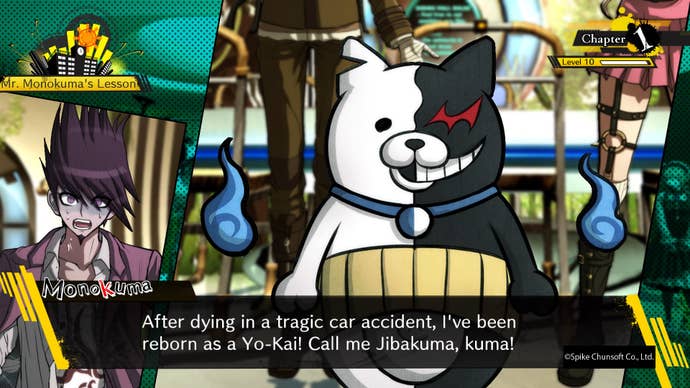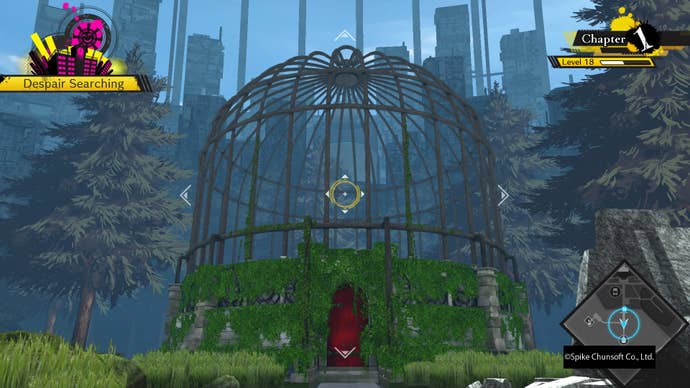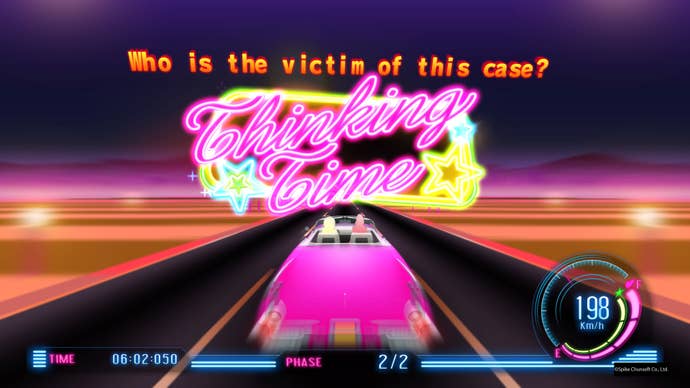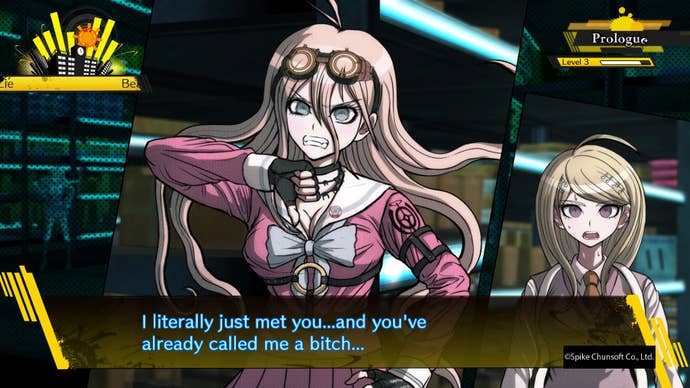Danganronpa V3: Killing Harmony Review: The Good Times Are Killing Me
Danganronpa V3: Killing Harmony is more of the murderous friendship building simulator you know and love.
This article first appeared on USgamer, a partner publication of VG247. Some content, such as this article, has been migrated to VG247 for posterity after USgamer's closure - but it has not been edited or further vetted by the VG247 team.
Your dead friends are always haunting you in Danganronpa V3: Killing Harmony (as with all Danganronpas, really). Their rooms lie next to yours, like empty tombs to remember them by. Their names and memories pop up frequently, abundant in nearly every conversation you carry with others. Even when they're gone, they're not really. And even when you're in a trial investigating yet another murder that befell your almost-peaceful group, their smiling portraits are propped up there. Usually with a big ol' X marked across their face to signify that, y'know, they're dead.
Danganronpa has always been a series synonymous with all things grim, yet retaining a pop-like perky flair. It's a series about teenagers murdering one another in a calmer, more calculated Battle Royale-esque scenario; only it's watched over by a sadistic teddy bear who acts as both judge and executioner. (You, the player, are the jury in a way.) It's a game where the crimes themselves are often complex, where the perpetrators (or even victims) are never obvious from a glance; yet the blood hardly looks lifelike at all, it's a neon pink haze.

Danganronpa V3 pins 16 talented teenagers, each with "Ultimate" abilities they were once praised for internationally (from Ultimate Pianist to Ultimate Entomologist), into a school. The school turns out to not be what it seems, with foliage growing into buildings, rooms that look like they haven't been used in nearly decades. The group is told by Monokuma, an eerie robotic teddy bear, that they're now participating in the Killing Game. A "game" where people have to murder one another, stand on trial, and if the murderer manages to escape the trial without being convicted, they're allowed to go free. For everyone else, they're executed. On the other hand, if the murderer is properly exposed, then only the murderer suffers an execution. (And a mighty theatrical one at the hands of Monokuma at that.) The Killing Game, Monokuma says, only goes on until two people are left standing, or a murderer successfully passes through a Class Trial scott free.
Danganronpa V3 borrows the same format as its two numbered predecessors. It's a visual novel in a school-like setting, where you walk around its expansive campus and spend your days choosing which characters you want to spend time with the most to inch your bonds closer, buying them gifts that they and only they would like depending on things they enjoy and their general personalities. Then a wrench gets thrown into the familiar visual novel method: the game tosses in multiple murder mysteries, and it's your job to gather evidence and solve them.
Like all good mysteries though, the answer is almost never apparent going into a trial. It's in talking through all the evidence with the friends you've come to know—and have been perhaps deceived by—that pieces start falling into place, and murders start getting solved.


The lineage of Danganronpa is a confounding one to outsiders. It's a franchise that's spanned manga, anime, and video games, the latter being where it all began in 2010 on the PlayStation Portable with Danganronpa: Trigger Happy Havoc. It's a visual novel series, at its barest description, but perhaps it's better described as a detective game. Players are given crime scenes to investigate, and then in a trial, they put all the facts they've collected to the test.
In Danganronpa V3, it's not only about the facts though. It's about the lies too. That's it's biggest departure from its predecessors.
Trials in Danganronpa have always been complicated. There's Nonstop Debates where you direct the evidence you've collected (now in the form of "Truth Bullets") at highlighted phrases that other characters say that flies across the screen, or sometimes you spell out a word or phrase in a game of hangman, and so on. Danganronpa V3 introduces many new mechanics to spice up class trials, making them more exciting and messy than ever before. For instance, players now have the opportunity to "lie" to steer a trial in their intended direction (within the section, it's usually telegraphed what the topic should be on, making deducing when it's appropriate to lie all the simpler—and less guilty feeling).


In the biggest departure, Pysche Taxi introduces an Outrun-like track accentuated by neon everything. The minigame directs you to hit letter blocks to form a question, and then answer the inquisition by running straight into a silhouette on the horizon. For some reason, the combination of smacking a taxi into a neon pink silhouette, watching them flip into the vehicle, and hearing a sensual voice say, "Good!" is an extremely satisfying sequence. Other new assets include Manic Panic Debate (where multiple characters talk over one another in a chaotic fashion), Mind Mine (where you destroy matching-colored blocks to reveal images and solve questions), and Debate Scrum (which divides characters onto two sides to argue a point).
There are some fumbles though. Sometimes what I needed to progress in a trial was just a tad bit too obtuse, such as fumbling through my "Truth Bullets" and unaware that I was supposed to be projecting lies to steer things. One particular case ends in a way that made me uncomfortable in the implications it was making towards mental illness. Although one controversial twist, while incredibly disappointing initially, luckily ends up being not such a bad turn after all.

Danganronpa V3 is really about friendship though, as with all Danganronpa games. In a dire environment, Danganronpa V3 explores the unexpected bonds that form between people in times of turmoil, and in turn also exploring the surprise betrayals people are prone to commit. Danganronpa V3's trials are mixed affair though. Some going into them, I already had vague conclusions I came to when going through my evidence that proved to be correct. For those, there were no in-trial revelations that shocked me. Though for a handful of the game's six trials (each amounting to a few hours each, not including investigation time prior), they rank among the best in the series. Always finding new ways to twist, turn, and genuinely surprise me along the way.
The cast of Danganronpa V3 is one of its strongest components, similar to past games. Whether growing closer to specific people during the Free Time you get on some days or solving murders within your circle together, every character goes through a deep arc that feels earned. Characters such as Ryoma Hoshi (Ultimate Tennis Pro) and Himiko Yumeno (Ultimate Magician) are hardly the characters they first were back when they stumbled out of lockers confusingly at the start. As for the player's character, they at last have a tangible personality and show real growth over the course of the game, no longer depending on pure luck to get them through investigating murders. Instead, they feel just as fully fleshed out as any of the other characters you meet.

Twists are what makes Danganronpa V3 even more distinct from its predecessors. As prefaced, Danganronpa V3 is not a direct continuation of the school-tethered world you thought you'd come to know. Its roads lead to wholly unexpected—and honestly, super ballsy and commendable—ends that players wouldn't expect. Throughout Danganronpa V3, I relished in its confusing and inventive crimes and the layered characters I grew close to over the course of the game. There's nothing else like the Danganronpa series, even if Danganronpa V3 doesn't quite soar to the heights of Danganronpa 2 proper.
I wouldn't be surprised if longtime Danganronpa fans are turned off by some of the twists and turns of Danganronpa V3. Yet as someone who's been along for the ride since the games ported to PlayStation Vita all those years ago, I was just happy to be taken along for any ride at all. It was never about the destination, just all the friends I avenged through solving their murders along the way.
InterfaceDanganronpa V3 has an incredibly stylish UI, matching the "psycho-cool" aesthetic across the rest of the game.
Lasting AppealDanganronpa V3's main story lasts about 40 to 50 hours. There's plenty to do afterwards, including the murder-free mode which allows players free time to grow close to and romance whoever characters they want without the pressure of them maybe getting murdered. Or y'know, murdering someone else.
ConclusionDanganronpa V3 might end up being a controversial entry for fans close to the series, but its twists and turns are worth seeing through. With additional minigames and mechanics, the trials are more exciting than they've ever been before; its cast is even more endearing than past games; and best of all, its murders are still a delight to solve. After all, there's no better feeling than personally realizing something before the game even points at it directly.









